Clinical Reasoning Cycle in Mental Health: A Nursing Case Study
VerifiedAdded on 2023/06/09
|10
|2617
|413
Case Study
AI Summary
This case study analyzes the case of Mr. John Gray, a 28-year-old male with severe depression and a history of suicide attempts, through the lens of Levett-Jones' Clinical Reasoning Cycle. The analysis focuses on assessing Mr. Gray's current condition, identifying key issues such as the risk of self-harm, reluctance to eat, and social withdrawal. The case study establishes goals for care, including conducting a mental state examination, improving nutritional intake, and managing wound care. It outlines specific actions to achieve these goals, such as creating a comfortable environment for the MSE, providing nutritious and appealing meals, and properly assessing and dressing wounds. The evaluation process involves monitoring weight, wound healing, and mental health outcomes. The reflection highlights the importance of ethical considerations, multidisciplinary collaboration, and evidence-based practice in nursing care, emphasizing the nurse's role in informed decision-making and person-centered care. The case study concludes that the Clinical Reasoning Cycle is a vital framework for nurses to practice reflectively and ethically, especially when caring for patients with severe depression and suicidal tendencies.
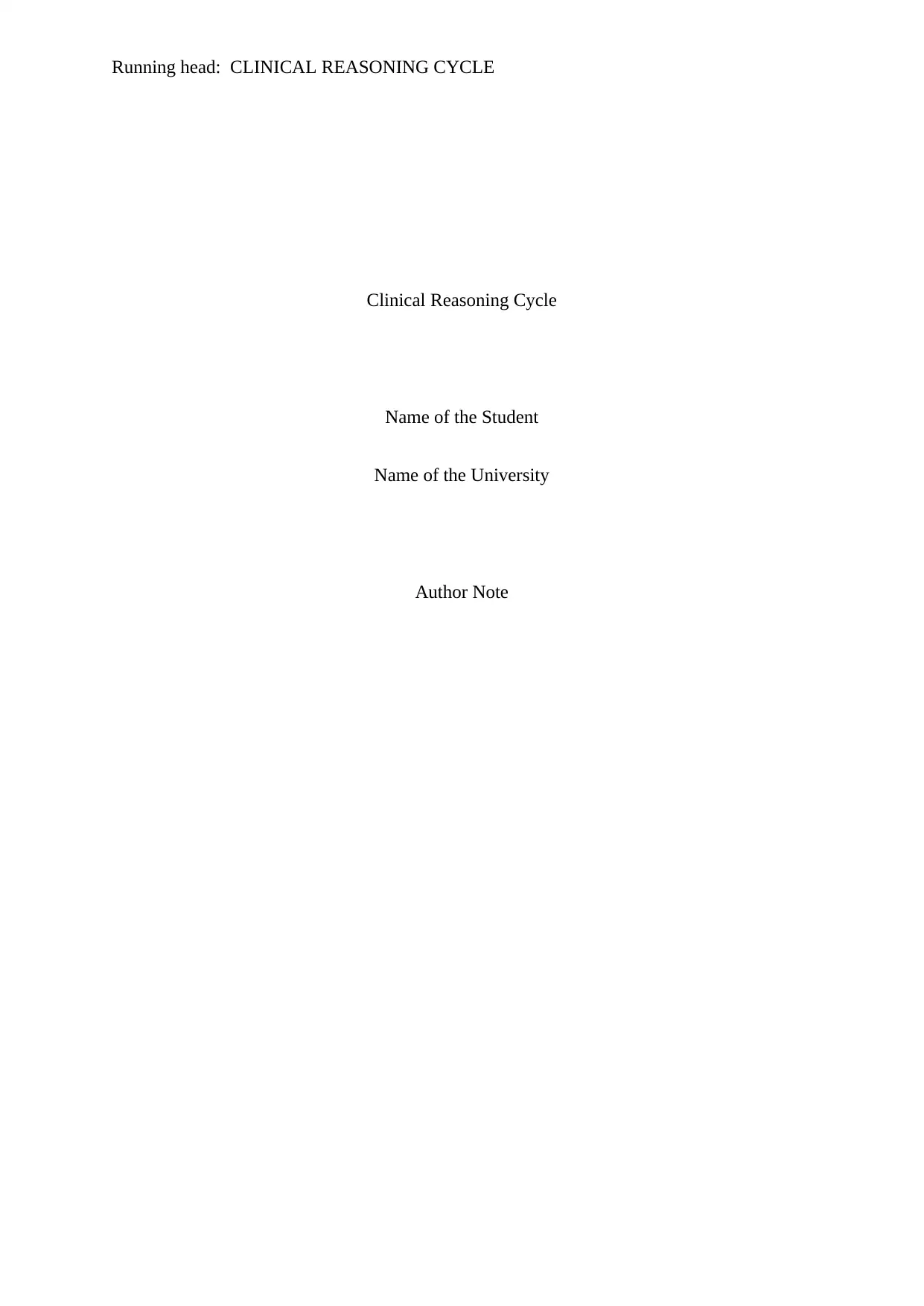
Running head: CLINICAL REASONING CYCLE
Clinical Reasoning Cycle
Name of the Student
Name of the University
Author Note
Clinical Reasoning Cycle
Name of the Student
Name of the University
Author Note
Paraphrase This Document
Need a fresh take? Get an instant paraphrase of this document with our AI Paraphraser
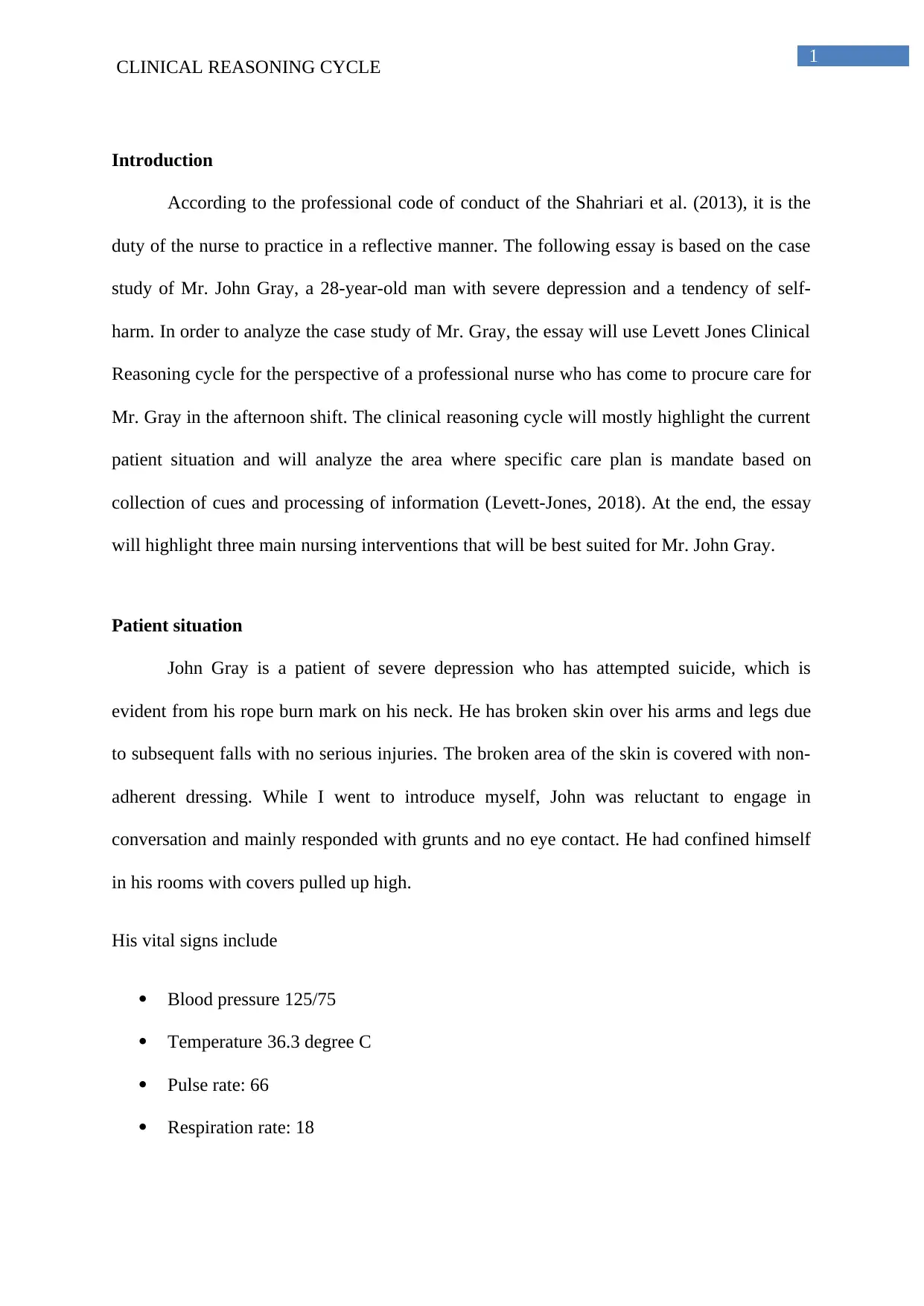
1
CLINICAL REASONING CYCLE
Introduction
According to the professional code of conduct of the Shahriari et al. (2013), it is the
duty of the nurse to practice in a reflective manner. The following essay is based on the case
study of Mr. John Gray, a 28-year-old man with severe depression and a tendency of self-
harm. In order to analyze the case study of Mr. Gray, the essay will use Levett Jones Clinical
Reasoning cycle for the perspective of a professional nurse who has come to procure care for
Mr. Gray in the afternoon shift. The clinical reasoning cycle will mostly highlight the current
patient situation and will analyze the area where specific care plan is mandate based on
collection of cues and processing of information (Levett-Jones, 2018). At the end, the essay
will highlight three main nursing interventions that will be best suited for Mr. John Gray.
Patient situation
John Gray is a patient of severe depression who has attempted suicide, which is
evident from his rope burn mark on his neck. He has broken skin over his arms and legs due
to subsequent falls with no serious injuries. The broken area of the skin is covered with non-
adherent dressing. While I went to introduce myself, John was reluctant to engage in
conversation and mainly responded with grunts and no eye contact. He had confined himself
in his rooms with covers pulled up high.
His vital signs include
Blood pressure 125/75
Temperature 36.3 degree C
Pulse rate: 66
Respiration rate: 18
CLINICAL REASONING CYCLE
Introduction
According to the professional code of conduct of the Shahriari et al. (2013), it is the
duty of the nurse to practice in a reflective manner. The following essay is based on the case
study of Mr. John Gray, a 28-year-old man with severe depression and a tendency of self-
harm. In order to analyze the case study of Mr. Gray, the essay will use Levett Jones Clinical
Reasoning cycle for the perspective of a professional nurse who has come to procure care for
Mr. Gray in the afternoon shift. The clinical reasoning cycle will mostly highlight the current
patient situation and will analyze the area where specific care plan is mandate based on
collection of cues and processing of information (Levett-Jones, 2018). At the end, the essay
will highlight three main nursing interventions that will be best suited for Mr. John Gray.
Patient situation
John Gray is a patient of severe depression who has attempted suicide, which is
evident from his rope burn mark on his neck. He has broken skin over his arms and legs due
to subsequent falls with no serious injuries. The broken area of the skin is covered with non-
adherent dressing. While I went to introduce myself, John was reluctant to engage in
conversation and mainly responded with grunts and no eye contact. He had confined himself
in his rooms with covers pulled up high.
His vital signs include
Blood pressure 125/75
Temperature 36.3 degree C
Pulse rate: 66
Respiration rate: 18
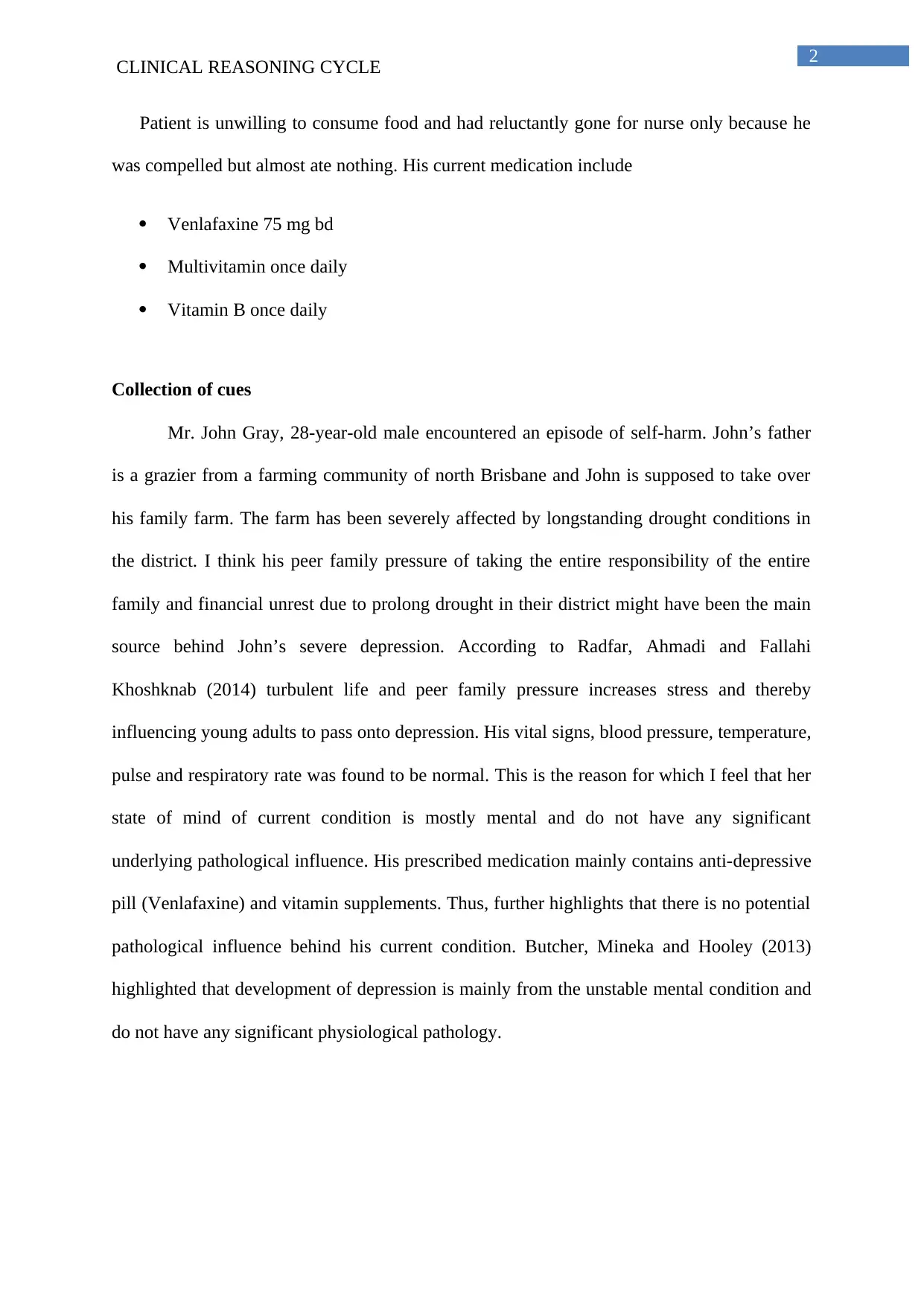
2
CLINICAL REASONING CYCLE
Patient is unwilling to consume food and had reluctantly gone for nurse only because he
was compelled but almost ate nothing. His current medication include
Venlafaxine 75 mg bd
Multivitamin once daily
Vitamin B once daily
Collection of cues
Mr. John Gray, 28-year-old male encountered an episode of self-harm. John’s father
is a grazier from a farming community of north Brisbane and John is supposed to take over
his family farm. The farm has been severely affected by longstanding drought conditions in
the district. I think his peer family pressure of taking the entire responsibility of the entire
family and financial unrest due to prolong drought in their district might have been the main
source behind John’s severe depression. According to Radfar, Ahmadi and Fallahi
Khoshknab (2014) turbulent life and peer family pressure increases stress and thereby
influencing young adults to pass onto depression. His vital signs, blood pressure, temperature,
pulse and respiratory rate was found to be normal. This is the reason for which I feel that her
state of mind of current condition is mostly mental and do not have any significant
underlying pathological influence. His prescribed medication mainly contains anti-depressive
pill (Venlafaxine) and vitamin supplements. Thus, further highlights that there is no potential
pathological influence behind his current condition. Butcher, Mineka and Hooley (2013)
highlighted that development of depression is mainly from the unstable mental condition and
do not have any significant physiological pathology.
CLINICAL REASONING CYCLE
Patient is unwilling to consume food and had reluctantly gone for nurse only because he
was compelled but almost ate nothing. His current medication include
Venlafaxine 75 mg bd
Multivitamin once daily
Vitamin B once daily
Collection of cues
Mr. John Gray, 28-year-old male encountered an episode of self-harm. John’s father
is a grazier from a farming community of north Brisbane and John is supposed to take over
his family farm. The farm has been severely affected by longstanding drought conditions in
the district. I think his peer family pressure of taking the entire responsibility of the entire
family and financial unrest due to prolong drought in their district might have been the main
source behind John’s severe depression. According to Radfar, Ahmadi and Fallahi
Khoshknab (2014) turbulent life and peer family pressure increases stress and thereby
influencing young adults to pass onto depression. His vital signs, blood pressure, temperature,
pulse and respiratory rate was found to be normal. This is the reason for which I feel that her
state of mind of current condition is mostly mental and do not have any significant
underlying pathological influence. His prescribed medication mainly contains anti-depressive
pill (Venlafaxine) and vitamin supplements. Thus, further highlights that there is no potential
pathological influence behind his current condition. Butcher, Mineka and Hooley (2013)
highlighted that development of depression is mainly from the unstable mental condition and
do not have any significant physiological pathology.
⊘ This is a preview!⊘
Do you want full access?
Subscribe today to unlock all pages.

Trusted by 1+ million students worldwide
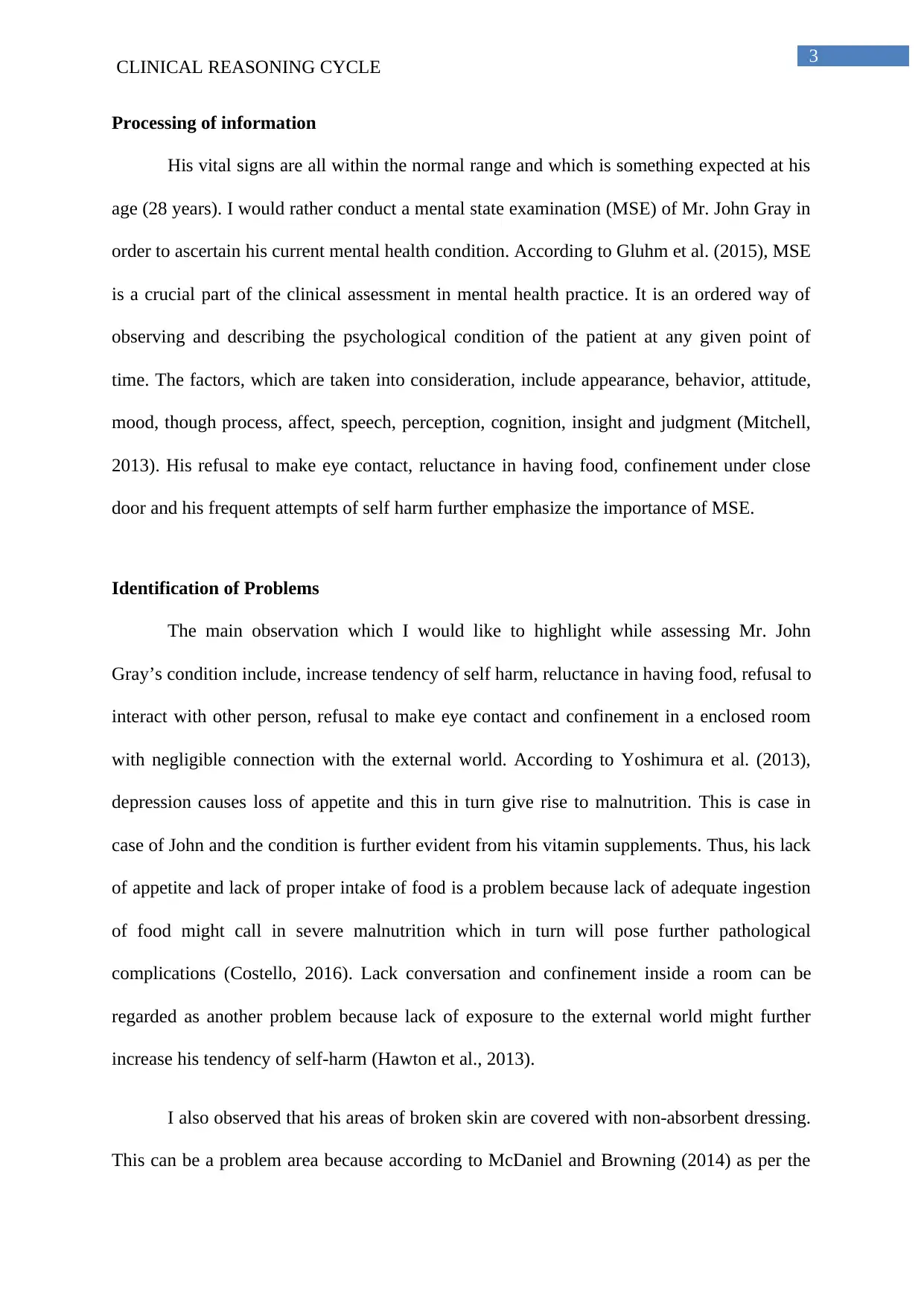
3
CLINICAL REASONING CYCLE
Processing of information
His vital signs are all within the normal range and which is something expected at his
age (28 years). I would rather conduct a mental state examination (MSE) of Mr. John Gray in
order to ascertain his current mental health condition. According to Gluhm et al. (2015), MSE
is a crucial part of the clinical assessment in mental health practice. It is an ordered way of
observing and describing the psychological condition of the patient at any given point of
time. The factors, which are taken into consideration, include appearance, behavior, attitude,
mood, though process, affect, speech, perception, cognition, insight and judgment (Mitchell,
2013). His refusal to make eye contact, reluctance in having food, confinement under close
door and his frequent attempts of self harm further emphasize the importance of MSE.
Identification of Problems
The main observation which I would like to highlight while assessing Mr. John
Gray’s condition include, increase tendency of self harm, reluctance in having food, refusal to
interact with other person, refusal to make eye contact and confinement in a enclosed room
with negligible connection with the external world. According to Yoshimura et al. (2013),
depression causes loss of appetite and this in turn give rise to malnutrition. This is case in
case of John and the condition is further evident from his vitamin supplements. Thus, his lack
of appetite and lack of proper intake of food is a problem because lack of adequate ingestion
of food might call in severe malnutrition which in turn will pose further pathological
complications (Costello, 2016). Lack conversation and confinement inside a room can be
regarded as another problem because lack of exposure to the external world might further
increase his tendency of self-harm (Hawton et al., 2013).
I also observed that his areas of broken skin are covered with non-absorbent dressing.
This can be a problem area because according to McDaniel and Browning (2014) as per the
CLINICAL REASONING CYCLE
Processing of information
His vital signs are all within the normal range and which is something expected at his
age (28 years). I would rather conduct a mental state examination (MSE) of Mr. John Gray in
order to ascertain his current mental health condition. According to Gluhm et al. (2015), MSE
is a crucial part of the clinical assessment in mental health practice. It is an ordered way of
observing and describing the psychological condition of the patient at any given point of
time. The factors, which are taken into consideration, include appearance, behavior, attitude,
mood, though process, affect, speech, perception, cognition, insight and judgment (Mitchell,
2013). His refusal to make eye contact, reluctance in having food, confinement under close
door and his frequent attempts of self harm further emphasize the importance of MSE.
Identification of Problems
The main observation which I would like to highlight while assessing Mr. John
Gray’s condition include, increase tendency of self harm, reluctance in having food, refusal to
interact with other person, refusal to make eye contact and confinement in a enclosed room
with negligible connection with the external world. According to Yoshimura et al. (2013),
depression causes loss of appetite and this in turn give rise to malnutrition. This is case in
case of John and the condition is further evident from his vitamin supplements. Thus, his lack
of appetite and lack of proper intake of food is a problem because lack of adequate ingestion
of food might call in severe malnutrition which in turn will pose further pathological
complications (Costello, 2016). Lack conversation and confinement inside a room can be
regarded as another problem because lack of exposure to the external world might further
increase his tendency of self-harm (Hawton et al., 2013).
I also observed that his areas of broken skin are covered with non-absorbent dressing.
This can be a problem area because according to McDaniel and Browning (2014) as per the
Paraphrase This Document
Need a fresh take? Get an instant paraphrase of this document with our AI Paraphraser
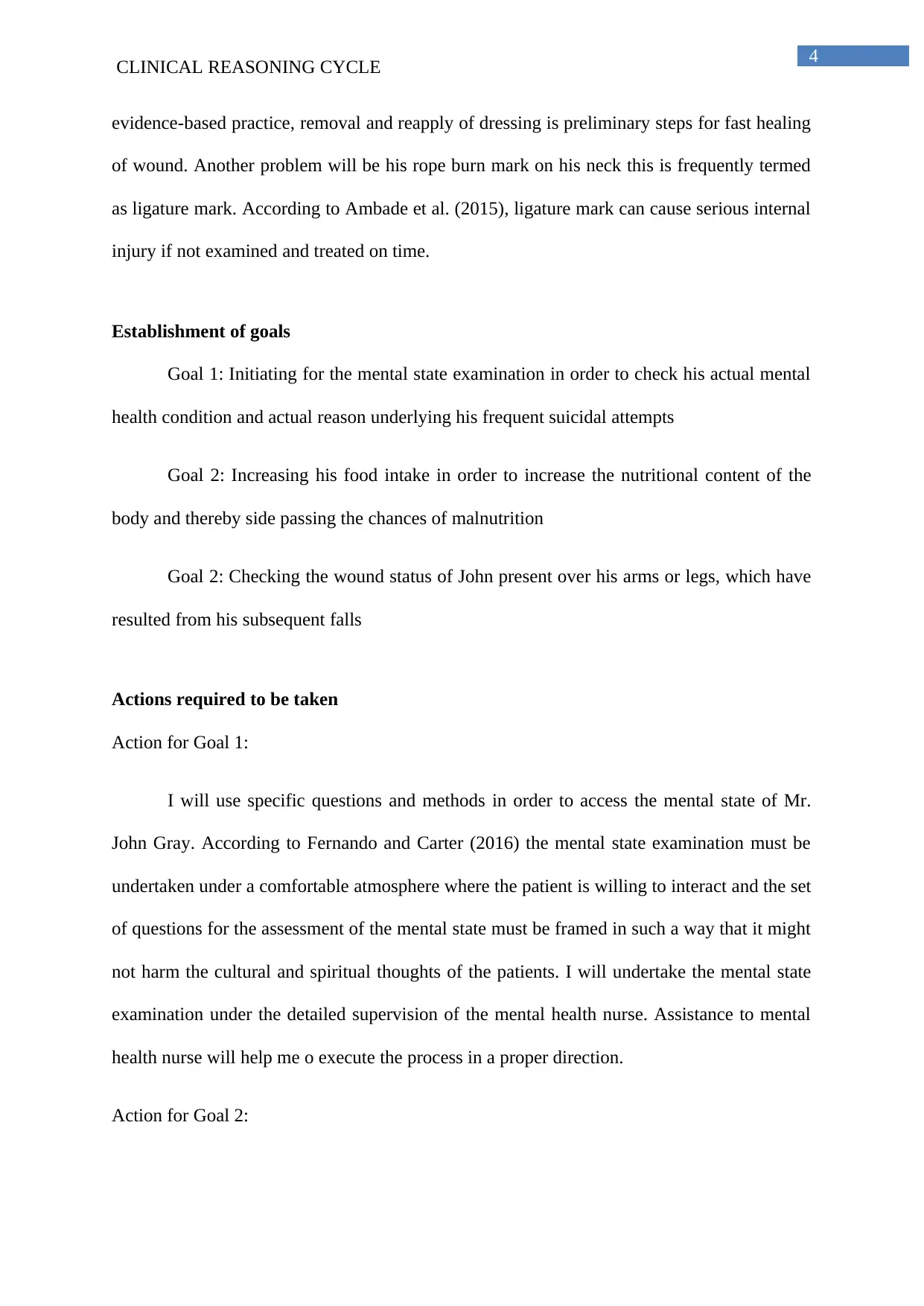
4
CLINICAL REASONING CYCLE
evidence-based practice, removal and reapply of dressing is preliminary steps for fast healing
of wound. Another problem will be his rope burn mark on his neck this is frequently termed
as ligature mark. According to Ambade et al. (2015), ligature mark can cause serious internal
injury if not examined and treated on time.
Establishment of goals
Goal 1: Initiating for the mental state examination in order to check his actual mental
health condition and actual reason underlying his frequent suicidal attempts
Goal 2: Increasing his food intake in order to increase the nutritional content of the
body and thereby side passing the chances of malnutrition
Goal 2: Checking the wound status of John present over his arms or legs, which have
resulted from his subsequent falls
Actions required to be taken
Action for Goal 1:
I will use specific questions and methods in order to access the mental state of Mr.
John Gray. According to Fernando and Carter (2016) the mental state examination must be
undertaken under a comfortable atmosphere where the patient is willing to interact and the set
of questions for the assessment of the mental state must be framed in such a way that it might
not harm the cultural and spiritual thoughts of the patients. I will undertake the mental state
examination under the detailed supervision of the mental health nurse. Assistance to mental
health nurse will help me o execute the process in a proper direction.
Action for Goal 2:
CLINICAL REASONING CYCLE
evidence-based practice, removal and reapply of dressing is preliminary steps for fast healing
of wound. Another problem will be his rope burn mark on his neck this is frequently termed
as ligature mark. According to Ambade et al. (2015), ligature mark can cause serious internal
injury if not examined and treated on time.
Establishment of goals
Goal 1: Initiating for the mental state examination in order to check his actual mental
health condition and actual reason underlying his frequent suicidal attempts
Goal 2: Increasing his food intake in order to increase the nutritional content of the
body and thereby side passing the chances of malnutrition
Goal 2: Checking the wound status of John present over his arms or legs, which have
resulted from his subsequent falls
Actions required to be taken
Action for Goal 1:
I will use specific questions and methods in order to access the mental state of Mr.
John Gray. According to Fernando and Carter (2016) the mental state examination must be
undertaken under a comfortable atmosphere where the patient is willing to interact and the set
of questions for the assessment of the mental state must be framed in such a way that it might
not harm the cultural and spiritual thoughts of the patients. I will undertake the mental state
examination under the detailed supervision of the mental health nurse. Assistance to mental
health nurse will help me o execute the process in a proper direction.
Action for Goal 2:
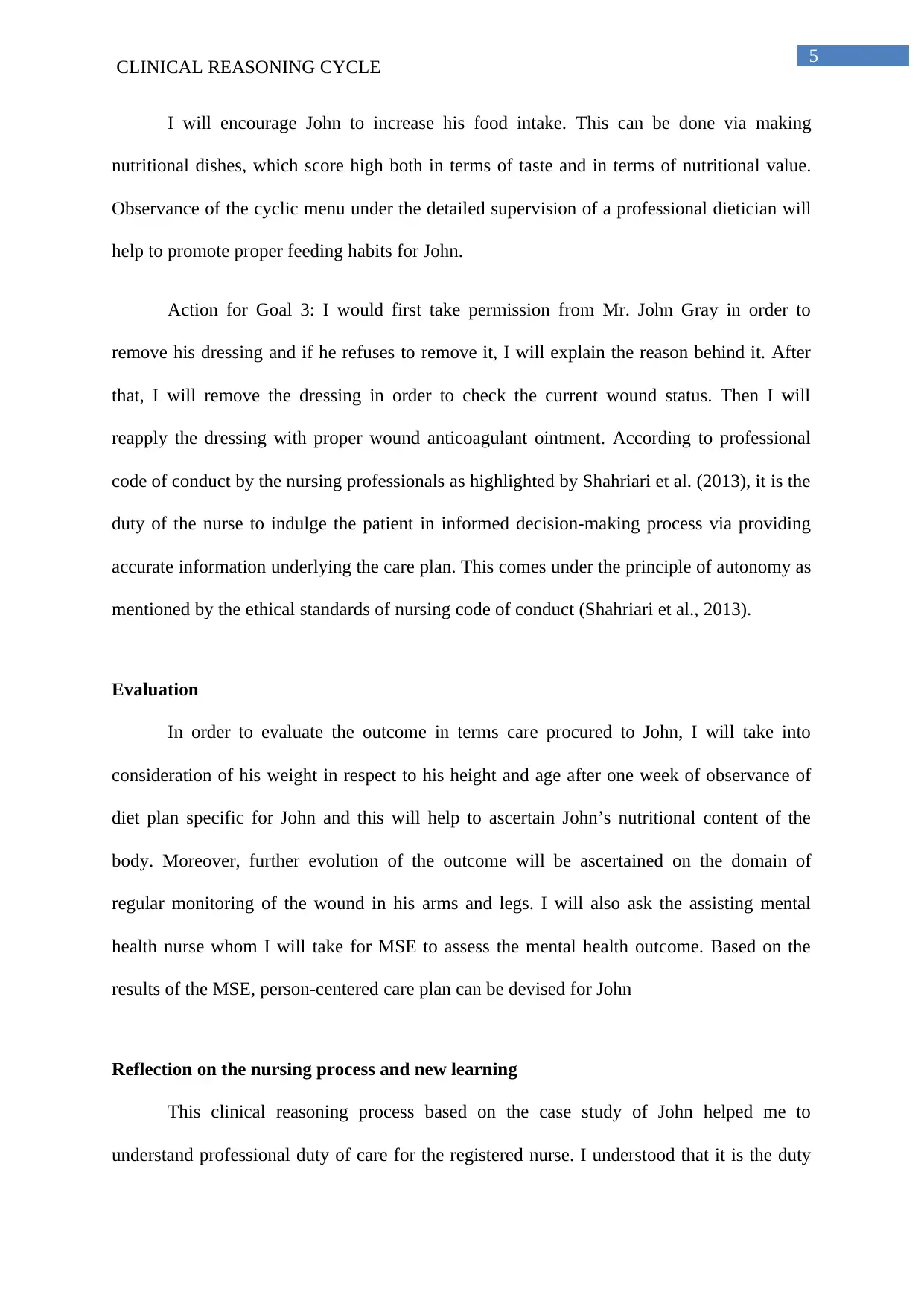
5
CLINICAL REASONING CYCLE
I will encourage John to increase his food intake. This can be done via making
nutritional dishes, which score high both in terms of taste and in terms of nutritional value.
Observance of the cyclic menu under the detailed supervision of a professional dietician will
help to promote proper feeding habits for John.
Action for Goal 3: I would first take permission from Mr. John Gray in order to
remove his dressing and if he refuses to remove it, I will explain the reason behind it. After
that, I will remove the dressing in order to check the current wound status. Then I will
reapply the dressing with proper wound anticoagulant ointment. According to professional
code of conduct by the nursing professionals as highlighted by Shahriari et al. (2013), it is the
duty of the nurse to indulge the patient in informed decision-making process via providing
accurate information underlying the care plan. This comes under the principle of autonomy as
mentioned by the ethical standards of nursing code of conduct (Shahriari et al., 2013).
Evaluation
In order to evaluate the outcome in terms care procured to John, I will take into
consideration of his weight in respect to his height and age after one week of observance of
diet plan specific for John and this will help to ascertain John’s nutritional content of the
body. Moreover, further evolution of the outcome will be ascertained on the domain of
regular monitoring of the wound in his arms and legs. I will also ask the assisting mental
health nurse whom I will take for MSE to assess the mental health outcome. Based on the
results of the MSE, person-centered care plan can be devised for John
Reflection on the nursing process and new learning
This clinical reasoning process based on the case study of John helped me to
understand professional duty of care for the registered nurse. I understood that it is the duty
CLINICAL REASONING CYCLE
I will encourage John to increase his food intake. This can be done via making
nutritional dishes, which score high both in terms of taste and in terms of nutritional value.
Observance of the cyclic menu under the detailed supervision of a professional dietician will
help to promote proper feeding habits for John.
Action for Goal 3: I would first take permission from Mr. John Gray in order to
remove his dressing and if he refuses to remove it, I will explain the reason behind it. After
that, I will remove the dressing in order to check the current wound status. Then I will
reapply the dressing with proper wound anticoagulant ointment. According to professional
code of conduct by the nursing professionals as highlighted by Shahriari et al. (2013), it is the
duty of the nurse to indulge the patient in informed decision-making process via providing
accurate information underlying the care plan. This comes under the principle of autonomy as
mentioned by the ethical standards of nursing code of conduct (Shahriari et al., 2013).
Evaluation
In order to evaluate the outcome in terms care procured to John, I will take into
consideration of his weight in respect to his height and age after one week of observance of
diet plan specific for John and this will help to ascertain John’s nutritional content of the
body. Moreover, further evolution of the outcome will be ascertained on the domain of
regular monitoring of the wound in his arms and legs. I will also ask the assisting mental
health nurse whom I will take for MSE to assess the mental health outcome. Based on the
results of the MSE, person-centered care plan can be devised for John
Reflection on the nursing process and new learning
This clinical reasoning process based on the case study of John helped me to
understand professional duty of care for the registered nurse. I understood that it is the duty
⊘ This is a preview!⊘
Do you want full access?
Subscribe today to unlock all pages.

Trusted by 1+ million students worldwide
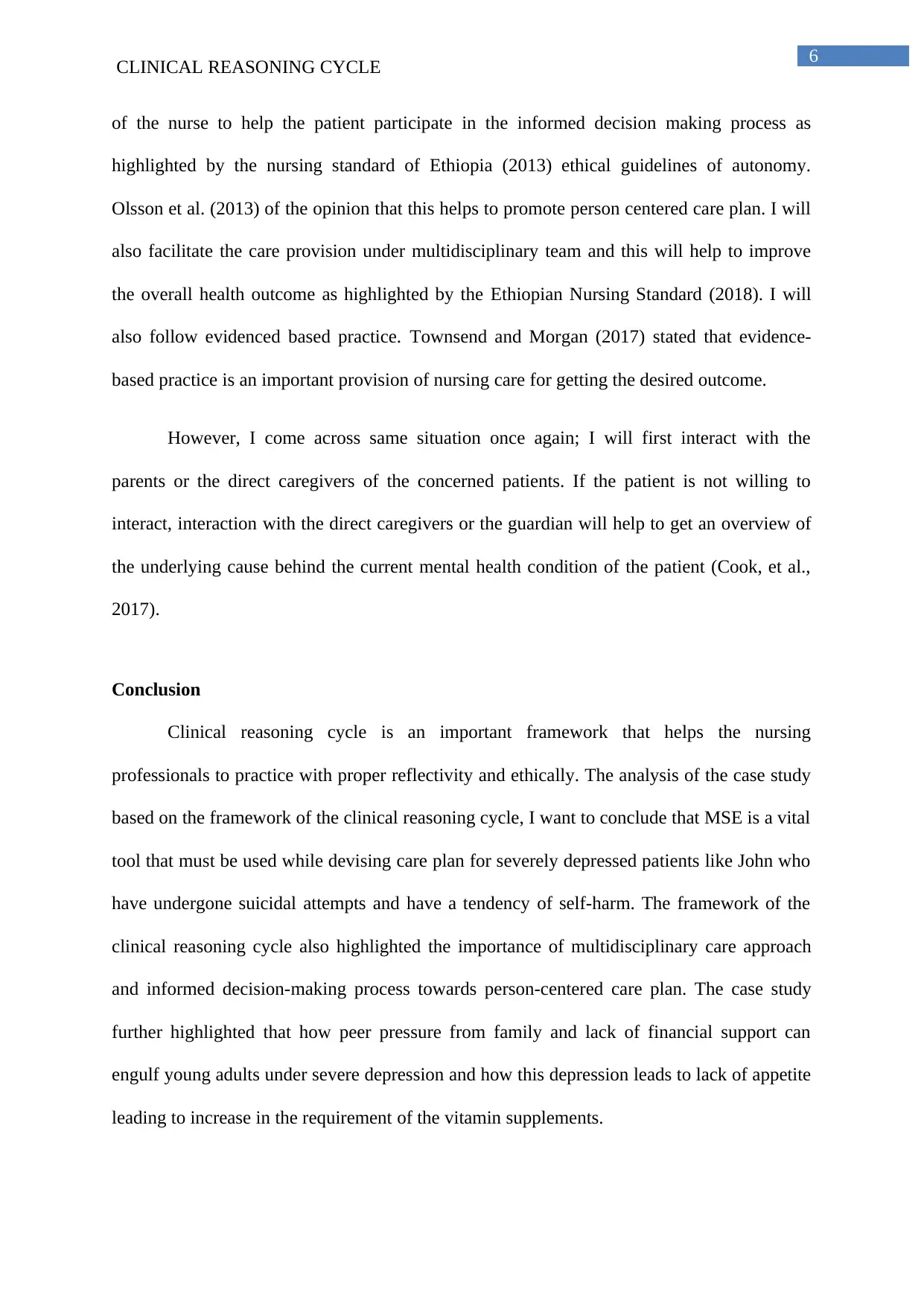
6
CLINICAL REASONING CYCLE
of the nurse to help the patient participate in the informed decision making process as
highlighted by the nursing standard of Ethiopia (2013) ethical guidelines of autonomy.
Olsson et al. (2013) of the opinion that this helps to promote person centered care plan. I will
also facilitate the care provision under multidisciplinary team and this will help to improve
the overall health outcome as highlighted by the Ethiopian Nursing Standard (2018). I will
also follow evidenced based practice. Townsend and Morgan (2017) stated that evidence-
based practice is an important provision of nursing care for getting the desired outcome.
However, I come across same situation once again; I will first interact with the
parents or the direct caregivers of the concerned patients. If the patient is not willing to
interact, interaction with the direct caregivers or the guardian will help to get an overview of
the underlying cause behind the current mental health condition of the patient (Cook, et al.,
2017).
Conclusion
Clinical reasoning cycle is an important framework that helps the nursing
professionals to practice with proper reflectivity and ethically. The analysis of the case study
based on the framework of the clinical reasoning cycle, I want to conclude that MSE is a vital
tool that must be used while devising care plan for severely depressed patients like John who
have undergone suicidal attempts and have a tendency of self-harm. The framework of the
clinical reasoning cycle also highlighted the importance of multidisciplinary care approach
and informed decision-making process towards person-centered care plan. The case study
further highlighted that how peer pressure from family and lack of financial support can
engulf young adults under severe depression and how this depression leads to lack of appetite
leading to increase in the requirement of the vitamin supplements.
CLINICAL REASONING CYCLE
of the nurse to help the patient participate in the informed decision making process as
highlighted by the nursing standard of Ethiopia (2013) ethical guidelines of autonomy.
Olsson et al. (2013) of the opinion that this helps to promote person centered care plan. I will
also facilitate the care provision under multidisciplinary team and this will help to improve
the overall health outcome as highlighted by the Ethiopian Nursing Standard (2018). I will
also follow evidenced based practice. Townsend and Morgan (2017) stated that evidence-
based practice is an important provision of nursing care for getting the desired outcome.
However, I come across same situation once again; I will first interact with the
parents or the direct caregivers of the concerned patients. If the patient is not willing to
interact, interaction with the direct caregivers or the guardian will help to get an overview of
the underlying cause behind the current mental health condition of the patient (Cook, et al.,
2017).
Conclusion
Clinical reasoning cycle is an important framework that helps the nursing
professionals to practice with proper reflectivity and ethically. The analysis of the case study
based on the framework of the clinical reasoning cycle, I want to conclude that MSE is a vital
tool that must be used while devising care plan for severely depressed patients like John who
have undergone suicidal attempts and have a tendency of self-harm. The framework of the
clinical reasoning cycle also highlighted the importance of multidisciplinary care approach
and informed decision-making process towards person-centered care plan. The case study
further highlighted that how peer pressure from family and lack of financial support can
engulf young adults under severe depression and how this depression leads to lack of appetite
leading to increase in the requirement of the vitamin supplements.
Paraphrase This Document
Need a fresh take? Get an instant paraphrase of this document with our AI Paraphraser
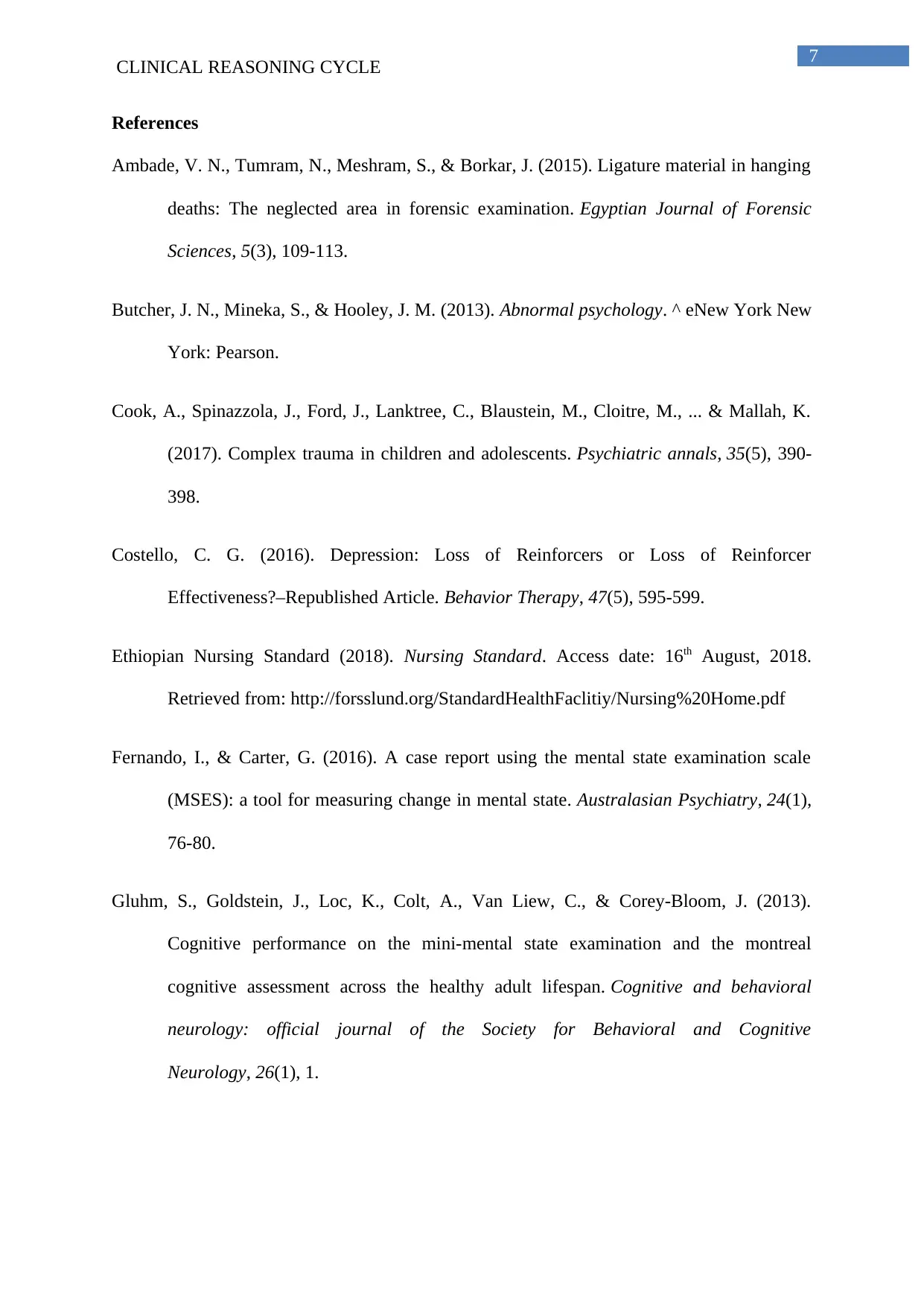
7
CLINICAL REASONING CYCLE
References
Ambade, V. N., Tumram, N., Meshram, S., & Borkar, J. (2015). Ligature material in hanging
deaths: The neglected area in forensic examination. Egyptian Journal of Forensic
Sciences, 5(3), 109-113.
Butcher, J. N., Mineka, S., & Hooley, J. M. (2013). Abnormal psychology. ^ eNew York New
York: Pearson.
Cook, A., Spinazzola, J., Ford, J., Lanktree, C., Blaustein, M., Cloitre, M., ... & Mallah, K.
(2017). Complex trauma in children and adolescents. Psychiatric annals, 35(5), 390-
398.
Costello, C. G. (2016). Depression: Loss of Reinforcers or Loss of Reinforcer
Effectiveness?–Republished Article. Behavior Therapy, 47(5), 595-599.
Ethiopian Nursing Standard (2018). Nursing Standard. Access date: 16th August, 2018.
Retrieved from: http://forsslund.org/StandardHealthFaclitiy/Nursing%20Home.pdf
Fernando, I., & Carter, G. (2016). A case report using the mental state examination scale
(MSES): a tool for measuring change in mental state. Australasian Psychiatry, 24(1),
76-80.
Gluhm, S., Goldstein, J., Loc, K., Colt, A., Van Liew, C., & Corey-Bloom, J. (2013).
Cognitive performance on the mini-mental state examination and the montreal
cognitive assessment across the healthy adult lifespan. Cognitive and behavioral
neurology: official journal of the Society for Behavioral and Cognitive
Neurology, 26(1), 1.
CLINICAL REASONING CYCLE
References
Ambade, V. N., Tumram, N., Meshram, S., & Borkar, J. (2015). Ligature material in hanging
deaths: The neglected area in forensic examination. Egyptian Journal of Forensic
Sciences, 5(3), 109-113.
Butcher, J. N., Mineka, S., & Hooley, J. M. (2013). Abnormal psychology. ^ eNew York New
York: Pearson.
Cook, A., Spinazzola, J., Ford, J., Lanktree, C., Blaustein, M., Cloitre, M., ... & Mallah, K.
(2017). Complex trauma in children and adolescents. Psychiatric annals, 35(5), 390-
398.
Costello, C. G. (2016). Depression: Loss of Reinforcers or Loss of Reinforcer
Effectiveness?–Republished Article. Behavior Therapy, 47(5), 595-599.
Ethiopian Nursing Standard (2018). Nursing Standard. Access date: 16th August, 2018.
Retrieved from: http://forsslund.org/StandardHealthFaclitiy/Nursing%20Home.pdf
Fernando, I., & Carter, G. (2016). A case report using the mental state examination scale
(MSES): a tool for measuring change in mental state. Australasian Psychiatry, 24(1),
76-80.
Gluhm, S., Goldstein, J., Loc, K., Colt, A., Van Liew, C., & Corey-Bloom, J. (2013).
Cognitive performance on the mini-mental state examination and the montreal
cognitive assessment across the healthy adult lifespan. Cognitive and behavioral
neurology: official journal of the Society for Behavioral and Cognitive
Neurology, 26(1), 1.
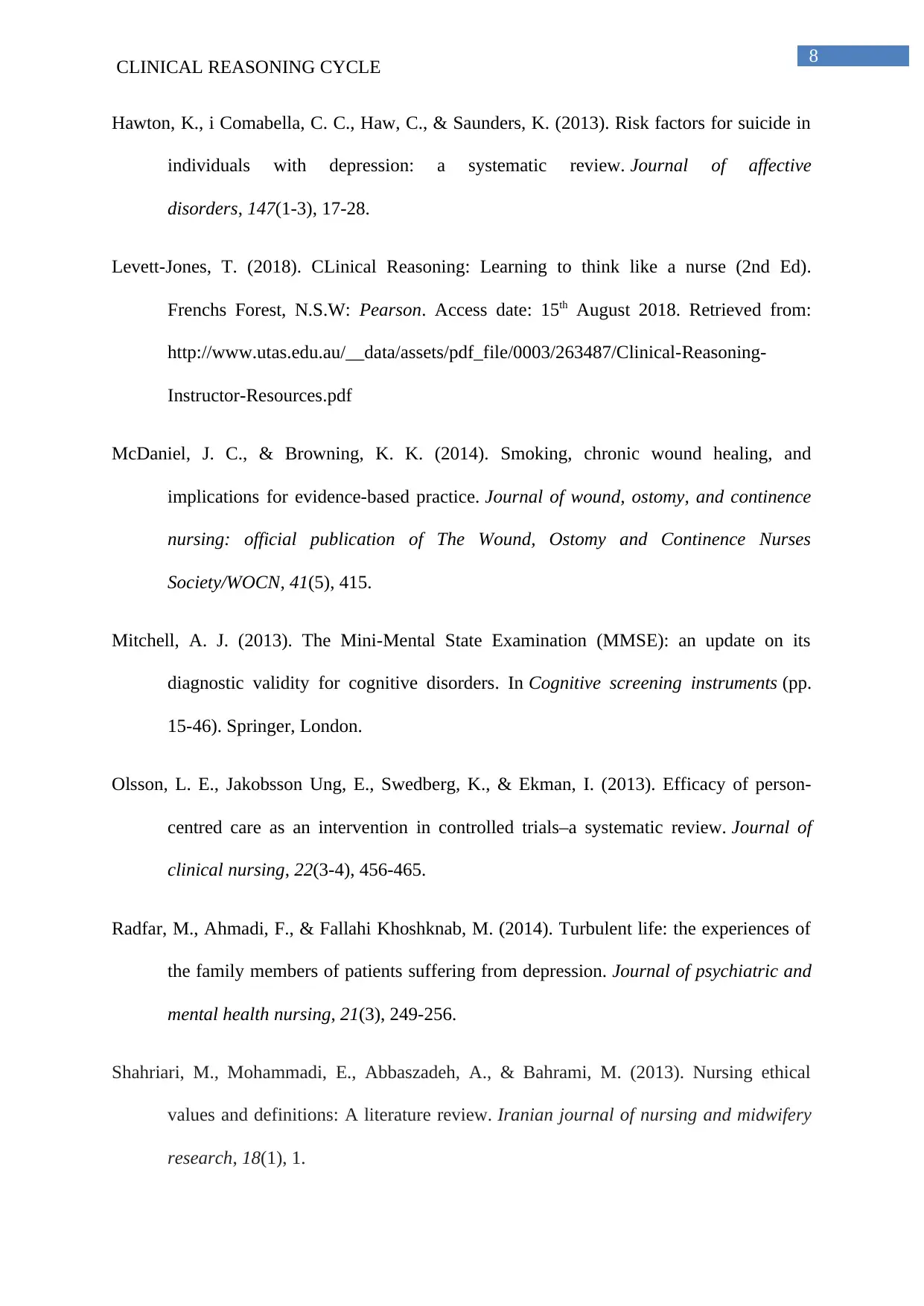
8
CLINICAL REASONING CYCLE
Hawton, K., i Comabella, C. C., Haw, C., & Saunders, K. (2013). Risk factors for suicide in
individuals with depression: a systematic review. Journal of affective
disorders, 147(1-3), 17-28.
Levett-Jones, T. (2018). CLinical Reasoning: Learning to think like a nurse (2nd Ed).
Frenchs Forest, N.S.W: Pearson. Access date: 15th August 2018. Retrieved from:
http://www.utas.edu.au/__data/assets/pdf_file/0003/263487/Clinical-Reasoning-
Instructor-Resources.pdf
McDaniel, J. C., & Browning, K. K. (2014). Smoking, chronic wound healing, and
implications for evidence-based practice. Journal of wound, ostomy, and continence
nursing: official publication of The Wound, Ostomy and Continence Nurses
Society/WOCN, 41(5), 415.
Mitchell, A. J. (2013). The Mini-Mental State Examination (MMSE): an update on its
diagnostic validity for cognitive disorders. In Cognitive screening instruments (pp.
15-46). Springer, London.
Olsson, L. E., Jakobsson Ung, E., Swedberg, K., & Ekman, I. (2013). Efficacy of person‐
centred care as an intervention in controlled trials–a systematic review. Journal of
clinical nursing, 22(3-4), 456-465.
Radfar, M., Ahmadi, F., & Fallahi Khoshknab, M. (2014). Turbulent life: the experiences of
the family members of patients suffering from depression. Journal of psychiatric and
mental health nursing, 21(3), 249-256.
Shahriari, M., Mohammadi, E., Abbaszadeh, A., & Bahrami, M. (2013). Nursing ethical
values and definitions: A literature review. Iranian journal of nursing and midwifery
research, 18(1), 1.
CLINICAL REASONING CYCLE
Hawton, K., i Comabella, C. C., Haw, C., & Saunders, K. (2013). Risk factors for suicide in
individuals with depression: a systematic review. Journal of affective
disorders, 147(1-3), 17-28.
Levett-Jones, T. (2018). CLinical Reasoning: Learning to think like a nurse (2nd Ed).
Frenchs Forest, N.S.W: Pearson. Access date: 15th August 2018. Retrieved from:
http://www.utas.edu.au/__data/assets/pdf_file/0003/263487/Clinical-Reasoning-
Instructor-Resources.pdf
McDaniel, J. C., & Browning, K. K. (2014). Smoking, chronic wound healing, and
implications for evidence-based practice. Journal of wound, ostomy, and continence
nursing: official publication of The Wound, Ostomy and Continence Nurses
Society/WOCN, 41(5), 415.
Mitchell, A. J. (2013). The Mini-Mental State Examination (MMSE): an update on its
diagnostic validity for cognitive disorders. In Cognitive screening instruments (pp.
15-46). Springer, London.
Olsson, L. E., Jakobsson Ung, E., Swedberg, K., & Ekman, I. (2013). Efficacy of person‐
centred care as an intervention in controlled trials–a systematic review. Journal of
clinical nursing, 22(3-4), 456-465.
Radfar, M., Ahmadi, F., & Fallahi Khoshknab, M. (2014). Turbulent life: the experiences of
the family members of patients suffering from depression. Journal of psychiatric and
mental health nursing, 21(3), 249-256.
Shahriari, M., Mohammadi, E., Abbaszadeh, A., & Bahrami, M. (2013). Nursing ethical
values and definitions: A literature review. Iranian journal of nursing and midwifery
research, 18(1), 1.
⊘ This is a preview!⊘
Do you want full access?
Subscribe today to unlock all pages.

Trusted by 1+ million students worldwide
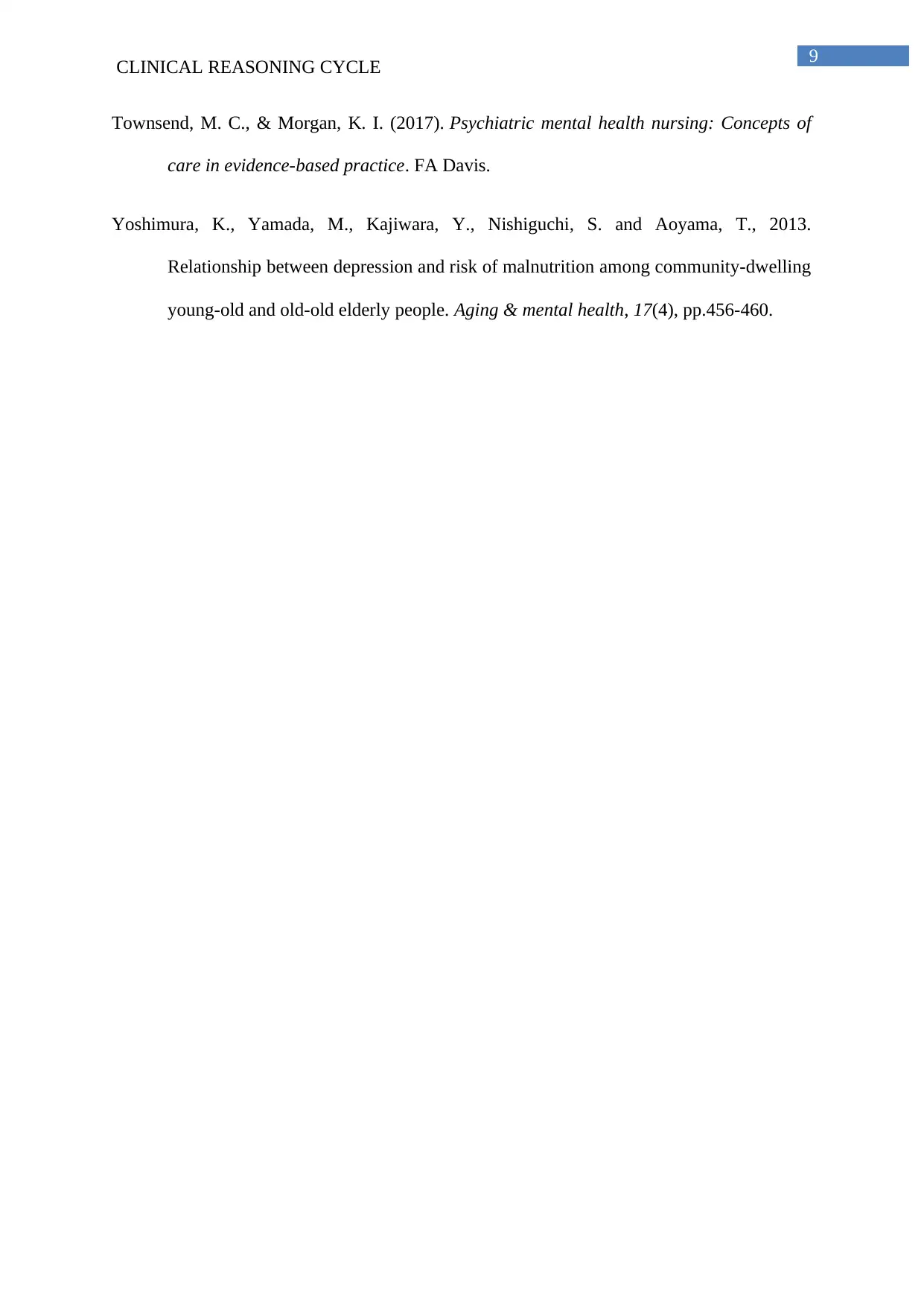
9
CLINICAL REASONING CYCLE
Townsend, M. C., & Morgan, K. I. (2017). Psychiatric mental health nursing: Concepts of
care in evidence-based practice. FA Davis.
Yoshimura, K., Yamada, M., Kajiwara, Y., Nishiguchi, S. and Aoyama, T., 2013.
Relationship between depression and risk of malnutrition among community-dwelling
young-old and old-old elderly people. Aging & mental health, 17(4), pp.456-460.
CLINICAL REASONING CYCLE
Townsend, M. C., & Morgan, K. I. (2017). Psychiatric mental health nursing: Concepts of
care in evidence-based practice. FA Davis.
Yoshimura, K., Yamada, M., Kajiwara, Y., Nishiguchi, S. and Aoyama, T., 2013.
Relationship between depression and risk of malnutrition among community-dwelling
young-old and old-old elderly people. Aging & mental health, 17(4), pp.456-460.
1 out of 10
Related Documents
Your All-in-One AI-Powered Toolkit for Academic Success.
+13062052269
info@desklib.com
Available 24*7 on WhatsApp / Email
![[object Object]](/_next/static/media/star-bottom.7253800d.svg)
Unlock your academic potential
Copyright © 2020–2025 A2Z Services. All Rights Reserved. Developed and managed by ZUCOL.





